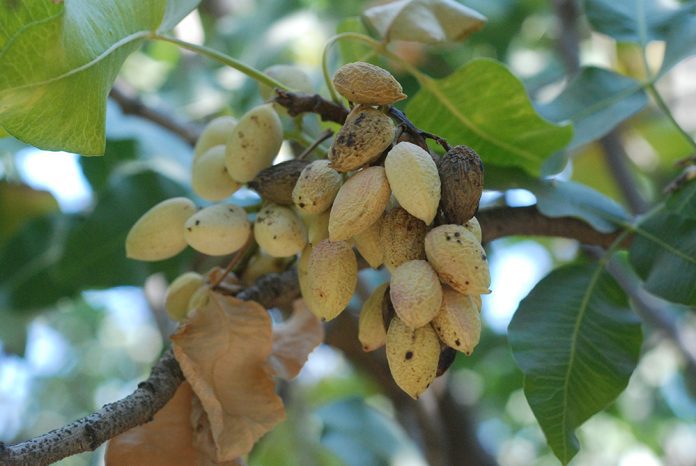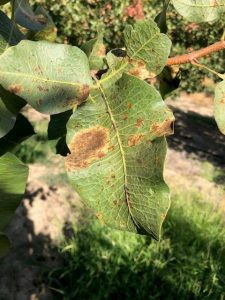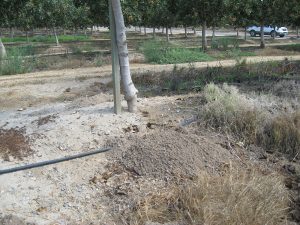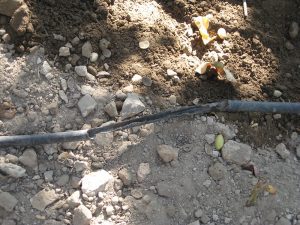
Dormancy is an important time for pistachio growers to prepare their orchards against critical pests: diseases, insects, rodents and weeds. UC ANR suggests an Integrated Pest Management (IPM) program for dormancy that includes removing and destroying mummy nuts from the trees and the orchard floor, as well as pruning out dead or infected wood, and removing or destroying the wood and any brush piles from the orchard floor.
Diseases
The main diseases affecting pistachio trees during dormancy are Botryosphaeria panicle and shoot blight, and Botrytis blossom and shoot blight, according to Mae Culumber, UCCE orchard crops farm advisor in Fresno County.
“Dead and dying branches, fruit-bearing rachises (stalk-bearing stems) and nut mummies provide inoculum sources for diseases,” she said. “Dormant-applied fungicides are not effective for control.”
Instead, Culumber advised to “prune out and destroy infected branches and unharvested nut mummies from trees, and shred or disc them into the soil.”
Themis Michailides, Ph.D., plant pathologist with UC Davis, also advised “pruning the affected shoots that have cankers.” He recommended waiting until April to use any fungicide.
“Spraying before then is not beneficial,” he said. “The fungicide can’t reach the inside tissues [of the trees] during dormancy,” he said.

Insect Pests
“Some of the main pests impacting pistachio are navel orangeworm (NOW), Gill’s mealybug and, increasingly, pests like stink bugs and leaffooted bugs,” said Culumber. “Navel orangeworm deposit eggs inside, splitting pistachios, and emerging larvae feed on the kernels. The [larvae] will overwinter in any unharvested nuts and continue their lifecycle, pupating and developing into the next generations of adults in spring of next season.
“Gill’s mealybug feed with piercing-sucking mouthparts on pistachio clusters and leaves,” she continued. “The feeding produces black sooty molds, which degrades kernel development and can increase shell staining. After harvest, adult females migrate from any remaining clusters to the trunk and main scaffolds where they form white, fuzzy aggregations on the bark. Stink bugs and leaffooted bugs are generally a problem earlier in the season. After nuts set and before the pistachio shell hardens, stink bugs and leaffooted bugs can pierce the developing shell.
“Sanitation is key for control of navel orangeworm, Gill’s mealybug, stink bug and leaffooted bug,” said Culumber. “Make sure to remove and destroy as many mummies and as much plant debris as possible. For mealybug, monitor and mark areas where black sooty mold or white aggregations are found. Check these same areas for adult females and crawlers at bud break and in late spring to make treatment decisions.”
To manage navel orangeworms, UC ANR recommends that growers remove unharvested nuts in the fall and winter, and then destroy any nuts on the ground. Many pistachio growers in California have benefitted by the practice of double shaking their trees as part of their winter sanitation. Growers are advised to wait to use insecticides.

“The most effective timing for insecticides to control mealybug is from late May to early June,” said Culumber. “Avoid postharvest treatments as they will reduce populations of natural mealybug predators that are abundant in the fall. Monitoring and management of stink bugs and leaffooted bugs begins in the following spring when stink bugs begin to emerge around April, although overwintering leaffooted bugs may be found even earlier in the year. The best cultural approach for controlling these small bugs is to clean debris in and around the orchard after harvest and during dormancy.”
Rodents
“Monitoring is always key to see what kind of pests are in the orchard,” said Roger Baldwin, Ph.D., wildlife specialist with the Department of Wildlife, Fish, and Conservation Biology at UC Davis, adding that rodents and other small animals can be a threat to a pistachio orchard, with ground squirrels and pocket gophers the most serious problems.
“We recommend that growers focus on Integrated Pest Management, just like they do for weeds and insects,” he said.
Two-pronged pincer traps, such as Macabee, Cinch or Gophinater, work best when there are little or no other food options for rodents. Bait stations are most effective for rats and mice during the winter months. Bait application for gophers is most effective within their burrow systems.
With pocket gophers, bait should be placed in the main tunnel. After locating an active tunnel, bait can be carefully deposited. Strychnine-treated grain is the most effective bait for pocket gopher control. Zinc phosphide baits can also be used and, like strychnine, they are lethal after a single dose. Anticoagulant baits can also be used but must be placed in larger amounts because they require multiple feedings to be effective.

Pocket gophers are a bigger threat to some orchards than to others, according to Baldwin. “We can see substantial damage in young orchards,” he said, explaining gophers can seriously damage the roots. “They have less impact in a 25-year-old orchard.
“Unless the rodent population is high, maybe action is not justified,” he said, noting many ground squirrels hibernate during dormancy. “Most are not active,” he said, recommending that burrow fumigation not be done until springtime.
Weeds
Managing weeds “depends on your attitude,” according to Phoebe Gordon, UCCE orchard crops farm advisor in Madera County.
“Some growers prefer complete control, and it would be best to apply an early winter preemergent herbicide mix that controls the ‘problem’ weeds in a particular orchard, with some post products mixed in to kill any weeds that emerged between your preharvest burndown and when you get your winter preemergent application on,” she said. “I think that this is costly, and it’s perfectly fine to leave a band of untreated weeds (aka resident winter vegetation) between the rows to get some of the benefits of cover crops and save on herbicide costs. You would of course need to treat the tree rows with preemergent herbicides.”
The advantages and disadvantages of herbicides are “a really complex topic,” said Gordon. “You need to weigh the cost of the product and application, the risk of pesticide resistance (are you rotating chemistries?), the need to treat the pest at hand, and any other environmental concerns. I know UC has strongly discouraged the use of certain pesticides during the dormant period because winter rains would wash pesticides out of orchards.”










